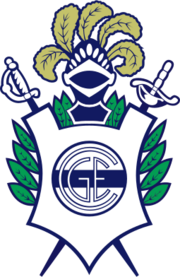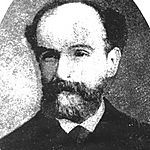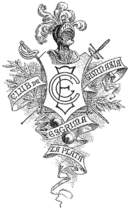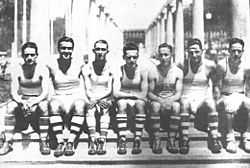Club de Gimnasia y Esgrima La Plata facts for kids
 |
|||
| Full name | Club de Gimnasia y Esgrima La Plata | ||
|---|---|---|---|
| Nickname(s) | El Lobo (The Wolf) Los Triperos (The gut-handlers) |
||
| Short name | CGE | ||
| Founded | 3 June 1887 | ||
| Ground | Estadio Juan Carmelo Zerillo | ||
| Capacity | 30,973 | ||
| President | Mariano Cowen | ||
| Manager | Alejandro Orfila | ||
| League | Primera División | ||
| 2024 | 19th | ||
|
|
|||
Club de Gimnasia y Esgrima La Plata is a professional sports club from La Plata, Argentina. It is often called simply Gimnasia. The club is most famous for its football (soccer) team. This team plays in the Primera División, which is the top football league in Argentina.
Gimnasia was founded on June 3, 1887. This makes it the oldest football club still playing in the Argentine league. A very famous football legend, Diego Maradona, was the team's manager from September 2019 until he passed away in November 2020.
Besides football, Gimnasia offers many other sports. These include athletics, basketball, boxing, chess, fencing, futsal, artistic gymnastics, field hockey, martial arts (like aikido and karate), swimming, roller skating, tennis, volleyball, and weightlifting.
Contents
Club History
Gimnasia y Esgrima La Plata was started on June 3, 1887. It began as a civil association. This makes it the oldest football club still active in the Argentine league. The club was founded just five years after the city of La Plata was created in 1882.
The first sports offered to members were gymnastics and fencing. These sports were popular among upper-class people in the late 1800s. Later, other sports like football, basketball, and rugby were added.
The club's name changed a few times over the years. For a short time in 1897, it was called "Club de Esgrima" (Fencing Club). This was because fencing was the only activity happening then. It soon went back to its original name. From 1952 to 1955, the club was named after Eva Perón, as the city of La Plata was also renamed. When the city's name changed back, so did the club's.
Gimnasia y Esgrima moved up to the first division in 1915. This happened after they won the División Intermedia championship. In 1929, the club won its first and only Primera División championship. They also won the Copa Centenario de la AFA in 1994. The team has been second place in the Primera División five times. Gimnasia has played in the top Argentine football league for 73 seasons. This is one of the longest participations at this level.
La Plata Derby
The Clásico Platense, or La Plata derby, is a football match. It is played between Gimnasia y Esgrima La Plata and Estudiantes de La Plata. These are the two main football teams in the city of La Plata.
The first official derby match was on August 27, 1916. Gimnasia won that game 1–0. The first derby in the professional era was on June 14, 1931. Gimnasia won five derby matches in a row between 1932 and 1934. This was a record until Estudiantes did the same from 2006 to 2008.
On June 25, 1963, Gimnasia had its biggest win against Estudiantes, 5–2. However, Gimnasia's worst loss was 7–0 on October 15, 2006.
A special moment in the derby happened on April 5, 1992. Gimnasia won 1–0 at Estudiantes' stadium. When the goal was scored, Gimnasia fans cheered so loudly that a local observatory's seismograph (an earthquake detector) recorded a small tremor! This goal, scored by José Perdomo, is still known as "El gol del terremoto" ("The earthquake goal").
Club Presidents
Gimnasia y Esgrima La Plata has had 56 presidents in over 120 years. These leaders are chosen to guide the club. Many presidents helped the club grow. Some are remembered for their achievements.
Saturnino Perdriel was the founder and first president. He was a merchant and worked for the government. He passed away in 1888, after one year as president.
Today, the club president is chosen by its members. Elections happen every three years. Any member over 18 who has been a member for at least three years can vote. Members with over seven years of membership can be elected to the club's Management Commission.
Gabriel Pellegrino was the president most recently. He was re-elected in December 2019 for a three-year term. This happened after manager Diego Maradona encouraged him to run again.
Club Facilities
Gimnasia has many facilities. These include its football stadium, a large training campus, a children's football campus, and a sports center. The club also has a kindergarten, a primary school, and a high school. There are also many smaller club branches around Argentina and the world.
- Estadio Juan Carmelo Zerillo: This is the football stadium. It is also known as El Bosque (Spanish for "the forest"). It is called this because it is in a park of the same name in La Plata. The stadium can hold about 24,544 fans.
- Estancia Chica: This is a large property of 160 hectares. The professional football team trains here before their matches.
- El Bosquecito: This is an 11-hectare campus. Children's football teams practice and play here.
- Schools: The club opened a kindergarten in 1999. A primary school, "Dr. René Favaloro," opened in 2001. A high school opened in early 2008.
- Polideportivo Gimnasia y Esgrima La Plata: This sports complex opened in 1978. It hosts basketball and volleyball games. It can hold 2,600 people for sports, and up to 3,500 for music shows.
- Headquarters: This building handles club administration and member services. Members can also play sports like basketball and volleyball here. It also has a gym.
Club Anthem
Gimnasia's official anthem was written in 1915. The poet Délfor B. Méndez wrote the words. The music was composed by Juan Serpentini. He also composed music for the Argentine National Anthem.
The anthem was first sung on July 9, 1915. This was during a welcome event for the delegation from the River Plate club from Uruguay. In 1967, the anthem was recorded by the Buenos Aires Police musical group.
Club Emblems and Colors
Club Badge
Gimnasia y Esgrima's current badge looks like a wreath. At the top, there is a helmet with a special crest. In the middle, on a white and navy-blue background (the club colors), you can see the club's letters. On the sides, there are parts of a saber and a foil (fencing swords). Laurels spread around the helmet.
The club's badge has changed a few times. The first symbol was on a document from 1888. It had the coat of arms of La Plata with the motto "Club de Gimnasia y Esgrima La Plata – Mens Sana in Corpore Sano" around it. This Latin phrase means "A healthy mind in a healthy body."
The first official badge was designed in 1901 by artist Emilio Coutauret. This design was very detailed. Because it was hard to print small, Raúl Felices designed a simpler one in 1928. This design has been used ever since.
For a time, the letters "CGE" (Club de Gimnasia y Esgrima) in the middle of the badge were changed to "GELP" (Gimnasia y Esgrima La Plata). But later, it was decided to go back to the original "CGE."
Team Uniform
Gimnasia y Esgrima's official uniform uses the colors from the club badge. It is a white jersey with one horizontal navy-blue stripe across the chest. This design is set in the club's rules.
When the club first started, the colors were white and light blue. This was to show that it was an Argentine club. The first jerseys had vertical white and light blue stripes.
In 1905, the club decided to change its colors. They wanted to be different from Racing Club. So, they chose vertical stripes of white and navy-blue.
Finally, in 1910, the design changed again. The vertical stripes became the single horizontal navy-blue band on a white jersey. This design has been used ever since.
Uniform Evolution
|
|
|
Apparel and Sponsors
Many companies have made the team's uniforms and sponsored the club.
|
|
Club Supporters
Fan Base
In La Plata, Gimnasia's fans were often seen as working-class people. This was different from Estudiantes' fans, who were mostly middle-class. Most Gimnasia fans live in the Greater La Plata area.
The club currently has 35,000 members. It is one of the top 10 clubs in Argentina with the most members.
A group of fans called themselves "La 22". This name came from 22nd street in La Plata. Many famous fans lived there. One famous fan was Marcelo Amuchástegui, known as Loco Fierro. He was known for big actions, like hanging a 100-meter Gimnasia flag in the Bombonera stadium.
Surveys in Argentina show that Gimnasia is the eighth most popular club in the country. Fans celebrate "Worldwide Day of Gimnasia's Fans" every year on December 10. They have a big party and gathering.
Team Nicknames
Since the 1960s, Gimnasia has been known as El Lobo (The Wolf). This nickname comes from the story of "Red Riding Hood." The team's stadium is in the middle of La Plata's main park, which is called El Bosque ("the forest"). So, they are "the wolf in the forest." Another nickname, mensanas, comes from the Latin motto on their badge: Mens sana in corpore sano (a healthy mind in a healthy body).
An older nickname is triperos ("gut-handlers"). This name came from the fact that many early Gimnasia fans worked in meat-processing plants nearby. In old newspaper cartoons, Gimnasia was shown as a "butcher." Fans still often shout "Tripa corazón!" (Spanish for "Heart of tripe!").
Another nickname is basureros ("garbage collectors"). This name came about in the 1970s. The club's president at that time also managed the company that collected trash in La Plata.
Club Stadium
The Juan Carmelo Zerillo stadium is known as El Bosque (the forest). It is located in the La Plata park of the same name. It used to hold 31,460 people and was used all the time until 2005.
A new city stadium was built in La Plata. Both Gimnasia and Estudiantes wanted to keep playing at their own fields. But new safety rules closed both stadiums. So, in 2006, Gimnasia started using the city stadium for home games.
During the Copa Sudamericana 2006, Gimnasia set a stadium record. Over 50,000 fans watched their match against Fluminense. Gimnasia won that game 2–0.
In March 2008, Gimnasia made changes to its old stadium. They wanted to get permission to use it again for some games. In June 2008, "El Bosque" was approved for top-division matches. On June 21, 2008, Gimnasia returned to its old home for a game against Lanús. The Juan Carmelo Zerillo stadium now holds 24,544 people.
Team Records
- Best position in First Division: 1st – First Division 1929
- Historic position in Argentine First Division: 8th place with 3461 points. They are behind River Plate, Boca Juniors, San Lorenzo, Club Atlético Independiente, Racing Club, Vélez Sarsfield, and Estudiantes de La Plata.
- Largest victories:
- 10–1 against River Plate (in 1905, playing in a lower division)
- 8–1 against Racing Club (November 22, 1961)
- In international games: 5–1 against Alianza Lima (at the Copa Libertadores 2003)
- Most consecutive victories:
- 8 wins (Apertura 2005) – This is the 6th best streak in Argentine football for short tournaments.
- 9 wins (1962)
- Worst defeats:
- In national championships: 0–8 against Huracán in First Division 1968.
- In international games: 0–4 against IA Sud América (at the Copa Conmebol 1995)
- Participation in international competitions:
- Copa Conmebol (3 times): 1992 (reached the Semi-finals), 1995, and 1998.
- Copa Sudamericana (4 times): 2002, 2006, 2014, and 2017.
- Copa Libertadores (2 times): 2003 and 2007.
Football Players
Over its 133-year history, more than 800 players have played for Gimnasia's first team. Many famous football players have come from its youth teams. These include Guillermo and Gustavo Barros Schelotto, Mariano Messera, Lucas Lobos, Roberto "Pampa" Sosa, Andrés Guglielminpietro, Sebastián Romero, Lucas Licht, Hernán Cristante, and Leandro Cufré.
Current Squad
|
|
Reserve Squad
|
Players on Loan
|
|
Individual Records
Most Appearances
| No. | Player | Pos. | Years Played | Matches |
|---|---|---|---|---|
| 1 | DF | 1992–2003, 2004–09 | 462 | |
| 2 | DF | 1991–2003 | 393 | |
| 3 | MF | 1932–45 | 343 | |
| 4 | DF | 1947–58 | 333 | |
| 5 | GK | 1990–2004 | 321 |
Top Scorers
| No. | Player | Pos. | Years Played | Goals |
|---|---|---|---|---|
| 1 | FW | 1927–43 | 95 | |
| 2 | FW | 1933–42 | 80 | |
| 3 | LW | 1934–46 | 75 | |
| 4 | FW | 1955–58, 1961–66 | 71 | |
| 5 | FW | 1997–2002 | 64 |
Current Coaching Staff
Last updated: 28 May 2025
Source: Liga Profesional de Fútbol
Team Managers
Since 1931, Gimnasia y Esgrima La Plata has had 63 managers (coaches). The first was Emérico Hirschl from Hungary. He coached the team from 1932 to 1934. He was also the first non-Argentine coach in Argentine football history.
Some important coaches for the team include Nito Veiga, who helped the team get promoted in 1984. Roberto Perfumo won the Copa Centenario de la AFA with the team. Carlos Griguol coached Gimnasia for ten years. Former player Pedro Troglio also managed the team.
 José Ripullone (1929–1930)
José Ripullone (1929–1930) Rafael Lafuente (1931)
Rafael Lafuente (1931) Emérico Hirschl (1932–1934)
Emérico Hirschl (1932–1934) Manuel Álvarez (1935)
Manuel Álvarez (1935) Máximo Garay (1937)
Máximo Garay (1937) Roberto Scarone (1948–51)
Roberto Scarone (1948–51) Adolfo Pedernera (1955)
Adolfo Pedernera (1955) Jorge Ormos (1959)
Jorge Ormos (1959) Carlos Aldabe (1960–61)
Carlos Aldabe (1960–61) Enrique Fernández Viola (1962)
Enrique Fernández Viola (1962) Adolfo Pedernera (1962)
Adolfo Pedernera (1962) Enrique Fernández Viola (1966), (1967)
Enrique Fernández Viola (1966), (1967) Juan Carlos Murúa (1968–69)
Juan Carlos Murúa (1968–69) José Varacka (1968–71)
José Varacka (1968–71) Juan Carlos Murúa (1971)
Juan Carlos Murúa (1971) José Varacka (1973–74), (1978–79)
José Varacka (1973–74), (1978–79) José Ramos Delgado (1989–90)
José Ramos Delgado (1989–90) Alberto Fanesi (1990–91)
Alberto Fanesi (1990–91) Roberto Perfumo (1993–94)
Roberto Perfumo (1993–94) Gregorio Pérez (1 Jan 1999 – 30 June 2000)
Gregorio Pérez (1 Jan 1999 – 30 June 2000) Carlos Griguol (2000–01)
Carlos Griguol (2000–01) Carlos Ramacciotti (1 Jan 2002 – 31 December 2003)
Carlos Ramacciotti (1 Jan 2002 – 31 December 2003) Carlos Griguol (2003–04)
Carlos Griguol (2003–04) Mario Gómez (2004)
Mario Gómez (2004) Carlos Ischia (1 July 2004 – 30 June 2005)
Carlos Ischia (1 July 2004 – 30 June 2005) Pedro Troglio (2005–07)
Pedro Troglio (2005–07) Francisco Maturana (1 April 2007 – 25 August 2007)
Francisco Maturana (1 April 2007 – 25 August 2007) Julio César Falcioni (1 July 2007 – 31 December 2007)
Julio César Falcioni (1 July 2007 – 31 December 2007) Guillermo Sanguinetti (31 Dec 2007–29 Sep 2008)
Guillermo Sanguinetti (31 Dec 2007–29 Sep 2008) Leonardo Madelón (30 Sep 2008–2 Dec 2009)
Leonardo Madelón (30 Sep 2008–2 Dec 2009) Pablo Fernández (interim) (1 Dec 2009 – 16 December 2009)
Pablo Fernández (interim) (1 Dec 2009 – 16 December 2009) Diego Cocca (1 Jan 2010–30 Sep 2010)
Diego Cocca (1 Jan 2010–30 Sep 2010) Pablo Morant (30 Sep 2010–31 Dec 2010)
Pablo Morant (30 Sep 2010–31 Dec 2010) Ángel Cappa (1 Jan 2011 – 28 April 2011)
Ángel Cappa (1 Jan 2011 – 28 April 2011) Darío Ortiz (29 April 2011 – 4 October 2011)
Darío Ortiz (29 April 2011 – 4 October 2011) Osvaldo Ingrao (1 July 2011 – 5 October 2011)
Osvaldo Ingrao (1 July 2011 – 5 October 2011) Pedro Troglio (6 Oct 2011 – 14 Mar 2016)
Pedro Troglio (6 Oct 2011 – 14 Mar 2016) Gustavo Alfaro (20 Mar 2016 – 13 May 2017)
Gustavo Alfaro (20 Mar 2016 – 13 May 2017) Leandro Martini (interim) (13 May 2017 – 24 Jun 2017)
Leandro Martini (interim) (13 May 2017 – 24 Jun 2017) Mariano Sosa (26 Jun 2017 – 28 Dec 2017)
Mariano Sosa (26 Jun 2017 – 28 Dec 2017) Facundo Sava (5 Jan 2018 – 21 Apr 2018)
Facundo Sava (5 Jan 2018 – 21 Apr 2018) Darío Ortiz (interim) (22 Apr 2018 – 14 May 2018)
Darío Ortiz (interim) (22 Apr 2018 – 14 May 2018) Pedro Troglio (15 May 2018 – 17 Feb 2019)
Pedro Troglio (15 May 2018 – 17 Feb 2019) Darío Ortiz (18 Feb 2019 – 31 Aug 2019)
Darío Ortiz (18 Feb 2019 – 31 Aug 2019) Diego Maradona (5 Sep 2019 – 25 Nov 2020)
Diego Maradona (5 Sep 2019 – 25 Nov 2020) Mariano Messera and
Mariano Messera and  Leandro Martini (26 Nov 2020 – 29 Aug 2021)
Leandro Martini (26 Nov 2020 – 29 Aug 2021) Néstor Gorosito (31 Aug 2021 – 30 Dec 2022)
Néstor Gorosito (31 Aug 2021 – 30 Dec 2022) Sebastián Romero (30 Dec 2022 – 2 Sep 2023)
Sebastián Romero (30 Dec 2022 – 2 Sep 2023) Leonardo Madelón (5 Sep 2023 – 14 Apr 2024)
Leonardo Madelón (5 Sep 2023 – 14 Apr 2024)
Other Sports at Gimnasia
Basketball started at the club in the 1920s. In 1924, the club built a stadium for basketball. It quickly became one of the club's most important sports.
The basketball team was very successful in 1978 and 1979. They won two Metropolitano championships. They beat Obras Sanitarias, which was a very strong team at the time. Famous players like "Gallego" González and "Finito" Gehrmann were on the team. American players Michael Jackson, Lawrence Jackson Jr., and star player Clarence Edgar Metcalfe also played. Metcalfe was even chosen as the league's best player in 1979.
Gimnasia also finished second in the 2003–04 Liga Nacional de Básquetbol (First Division). They lost to Boca Juniors in the final. The next season, the team moved down to the Second Division. This happened because the club's president cut the basketball budget. This caused many main players to leave.
Some other notable basketball players for Gimnasia were Carlos "Gallego" González and Ernesto "Finito" Gehrmann. Important coaches included José Ripullone and Miguel Ángel Ripullone.
Gimnasia y Esgrima also has a female volleyball team. They are one of the original nine clubs that started the Federación de Voleibol y Pelota al Cesto. This federation is now called Federación Metropolitana de Voleibol (FMV). Gimnasia's team still plays in the highest division.
Past Sports
Gimnasia y Esgrima La Plata used to have other sports that are no longer played at the club:
- Rugby union: In 1933, the rugby union decided not to allow clubs that played professional football. So, Gimnasia's rugby team had to change its name. Four years later, the rugby activities became a separate club, La Plata Rugby Club. This club still plays today.
- Table tennis: The "La Plata Association for Table-tennis" existed from 1945 to 1951. Gimnasia was a founding member and won most of the tournaments during those years.
- Greco-Roman wrestling: From 1924 to 1928, the club had a Greco-Roman wrestling team.
- Gymnastics: In the 1930s, gymnastics was very important at the club. Members of Gimnasia's gymnastics team were part of Argentina's team at the 1936 Berlin Olympic Games. This sport stopped being practiced after 1976.
Other activities offered at different times included water polo, boxing, cycling, pétanque, auto racing, and judo.
Club Honours
Senior Titles
- Keys
- Record
- (s) Shared record
| Type | Competition | Titles | Winning years |
|---|---|---|---|
| National (League) |
Primera División | 1 | 1929 |
| National (Cups) |
Copa Centenario de la AFA | 1 |
1993
|
Other Titles
Titles won in lower divisions:
- Primera B (3): 1944, 1947, 1952
- División Intermedia (1): 1915
- Copa Bullrich (1): 1915
Friendly Titles
- Trofeo Eva Perón (1): 1953
- Copa Gobernador Alende (1): 1960
- Copa Diario El Día (1): 1974
- Copa Diario La Gaceta (2): 1975 y 1977
- Copa Amistad (1): 1977 y 2006
- Copa Provincia de Buenos Aires (1): 1998
- Copa Municipalidad de La Plata (2): 1999 y 2001
- Copa Malvinas Argentinas (1): 2003
- Copa Ciudad de Mar del Plata (1): 2009
- Copa Ciudad de Necochea (1): 2012
- Copa Amistad Ciudad de La Plata (1): 2014
- Copa Ciudad de Ensenada (1): 2016
- Copa Banco Provincia (1): 2017
- Copa de Verano Schneider (2): 2018, 2019
Basketball Honours
- Torneo Nacional de Ascenso (1): 2000–01
- Campeonato Argentino de Clubes (2): 1979, 1980
- Federación de Capital Federal's League (3): 1937, 1978, 1979, 1984, 1985
- Asociación Platense de Básquet (13): 1958, 1961, 1962, 1963, 1965, 1966, 1967, 1968, 1969, 1970, 1971, 1972, 1973
- Copa "Ismael Genaro Cerisola" (1): 1996
Women's Volleyball Honours
Official Titles
- Argentine National League (3): 1999–00, 2000–01, 2002–03
- Federación Metropolitana (1): 2000
- Liga Metropolitana (1): 2004
Friendly Titles
- Copa Morgan (1): 1951
- Torneos Evita (1): 1954
- Torneo Lola Berta (1): 1955
- Torneo Cuadrangular Chile (1): 1972, 1975
- Torneo Cuadrangular Náutico de Uruguay (1): 1976
- Torneo Norma Rimoldi (1): 2005
See also
 In Spanish: Club de Gimnasia y Esgrima La Plata para niños
In Spanish: Club de Gimnasia y Esgrima La Plata para niños
- History of Club de Gimnasia y Esgrima La Plata (Football)
- Gimnasia y Esgrima (basketball)
- Presidents of Club de Gimnasia y Esgrima La Plata
- Estadio Juan Carlos Zerillo
- La Plata derby








